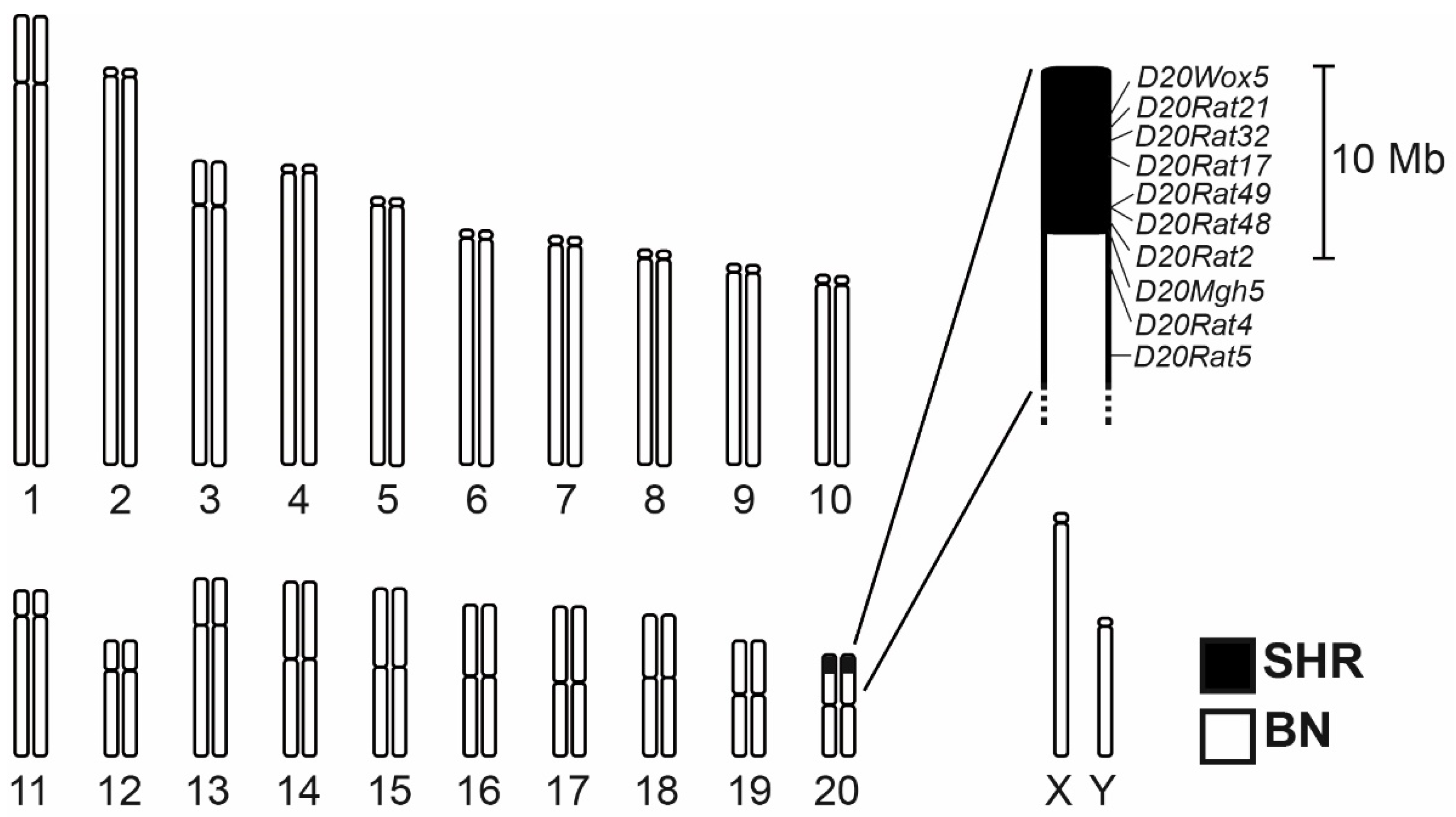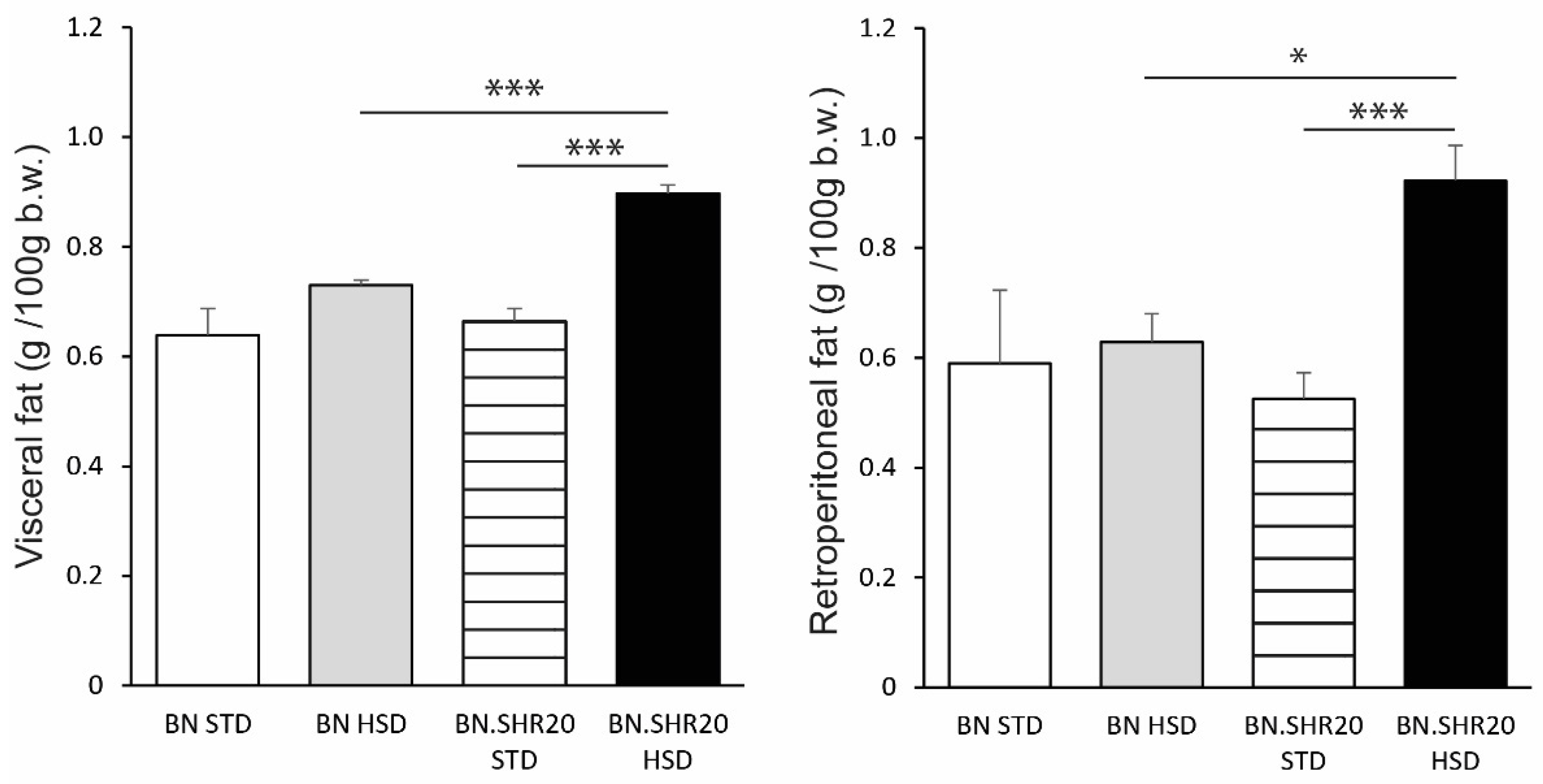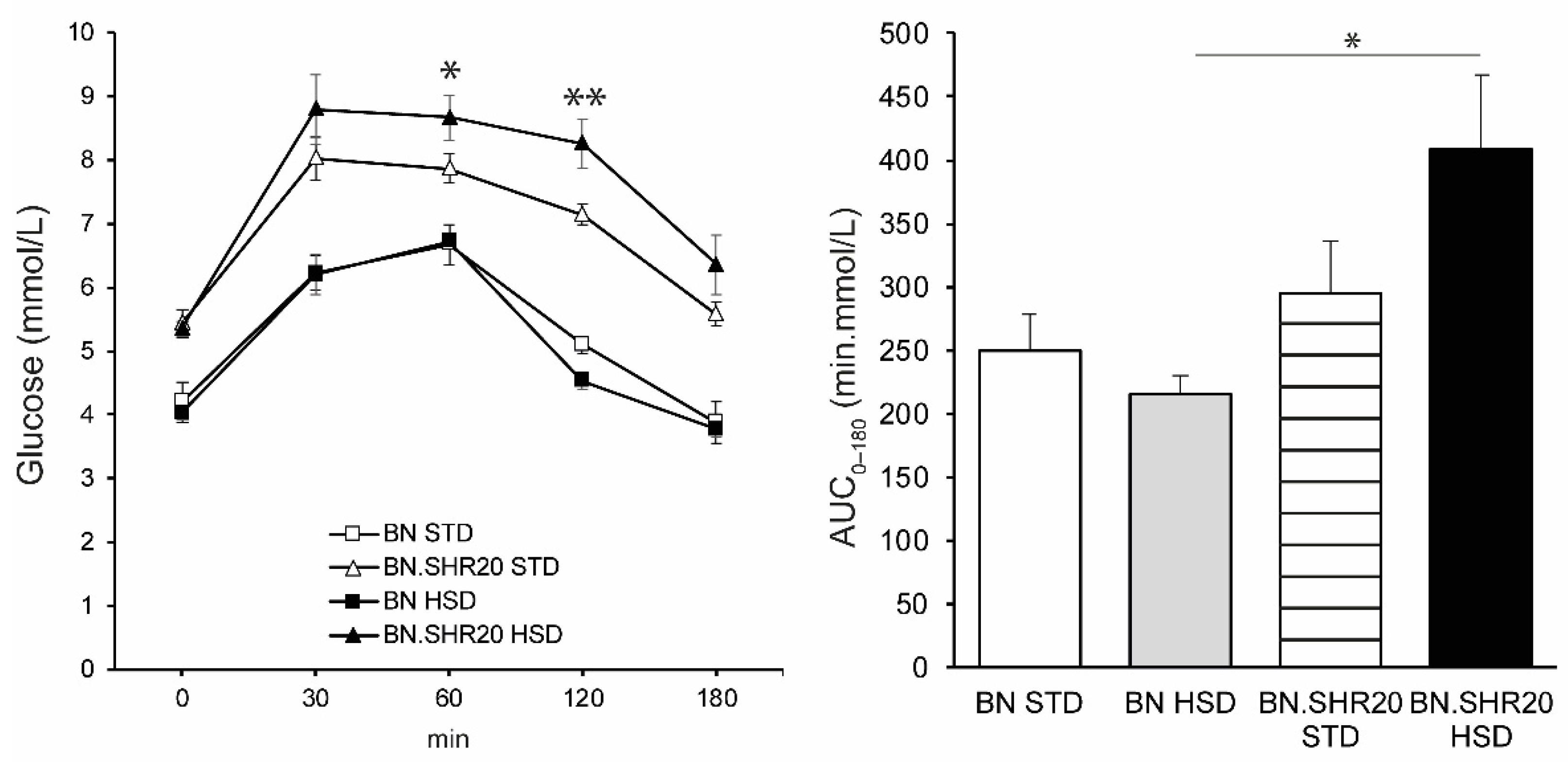Nutrigenetic Interaction of Spontaneously Hypertensive Rat Chromosome 20 Segment and High-Sucrose Diet Sensitizes to Metabolic Syndrome
Abstract
1. Introduction
2. Materials and Methods
2.1. Ethical Statement
2.2. Derivation of the BN.SHR20 Congenic Rat Strain
2.3. DNA Extraction and Genotyping
2.4. Experimental Protocol
2.5. Metabolic Measurements
2.6. In Silico Analyses
2.7. Statistical Analysis
3. Results
3.1. Genomic Characterization of the BN.SHR20 Congenic Strain
3.2. Nutrigenetic Effects of the RNO20 Differential Segment
3.3. Prioritization of Candidate Genes
4. Discussion
Supplementary Materials
Author Contributions
Funding
Institutional Review Board Statement
Data Availability Statement
Acknowledgments
Conflicts of Interest
References
- Alberti, K.G.; Eckel, R.H.; Grundy, S.M.; Zimmet, P.Z.; Cleeman, J.I.; Donato, K.A.; Fruchart, J.C.; James, W.P.; Loria, C.M.; Smith, S.C., Jr.; et al. Harmonizing the metabolic syndrome: A joint interim statement of the International Diabetes Federation Task Force on Epidemiology and Prevention; National Heart, Lung, and Blood Institute; American Heart Association; World Heart Federation; International Atherosclerosis Society; and International Association for the Study of Obesity. Circulation 2009, 120, 1640–1645. [Google Scholar] [CrossRef] [PubMed]
- Noubiap, J.J.; Nansseu, J.R.; Lontchi-Yimagou, E.; Nkeck, J.R.; Nyaga, U.F.; Ngouo, A.T.; Tounouga, D.N.; Tianyi, F.L.; Foka, A.J.; Ndoadoumgue, A.L.; et al. Geographic distribution of metabolic syndrome and its components in the general adult population: A meta-analysis of global data from 28 million individuals. Diabetes Res. Clin. Pract. 2022, 188, 109924. [Google Scholar] [CrossRef] [PubMed]
- Clark, K.C.; Kwitek, A.E. Multi-Omic Approaches to Identify Genetic Factors in Metabolic Syndrome. Compr. Physiol. 2021, 12, 3045–3084. [Google Scholar] [CrossRef] [PubMed]
- Aitman, T.; Dhillon, P.; Geurts, A.M. A RATional choice for translational research? Dis. Model Mech. 2016, 9, 1069–1072. [Google Scholar] [CrossRef] [PubMed]
- Szpirer, C. Rat models of human diseases and related phenotypes: A systematic inventory of the causative genes. J. Biomed. Sci. 2020, 27, 84. [Google Scholar] [CrossRef] [PubMed]
- Seda, O.; Liska, F.; Krenova, D.; Kazdova, L.; Sedova, L.; Zima, T.; Peng, J.; Pelinkova, K.; Tremblay, J.; Hamet, P.; et al. Dynamic genetic architecture of metabolic syndrome attributes in the rat. Physiol. Genom. 2005, 21, 243–252. [Google Scholar] [CrossRef] [PubMed][Green Version]
- Wallis, R.H.; Collins, S.C.; Kaisaki, P.J.; Argoud, K.; Wilder, S.P.; Wallace, K.J.; Ria, M.; Ktorza, A.; Rorsman, P.; Bihoreau, M.T.; et al. Pathophysiological, genetic and gene expression features of a novel rodent model of the cardio-metabolic syndrome. PLoS ONE 2008, 3, e2962. [Google Scholar] [CrossRef]
- Strahorn, P.; Graham, D.; Charchar, F.J.; Sattar, N.; McBride, M.W.; Dominiczak, A.F. Genetic determinants of metabolic syndrome components in the stroke-prone spontaneously hypertensive rat. J. Hypertens. 2005, 23, 2179–2186. [Google Scholar] [CrossRef]
- Seda, O.; Sedova, L.; Liska, F.; Krenova, D.; Prejzek, V.; Kazdova, L.; Tremblay, J.; Hamet, P.; Kren, V. Novel double-congenic strain reveals effects of spontaneously hypertensive rat chromosome 2 on specific lipoprotein subfractions and adiposity. Physiol. Genom. 2006, 27, 95–102. [Google Scholar] [CrossRef][Green Version]
- Pravenec, M.; Zidek, V.; Simakova, M.; Kren, V.; Krenova, D.; Horky, K.; Jachymova, M.; Mikova, B.; Kazdova, L.; Aitman, T.J.; et al. Genetics of Cd36 and the clustering of multiple cardiovascular risk factors in spontaneous hypertension. J. Clin. Investig. 1999, 103, 1651–1657. [Google Scholar] [CrossRef]
- Kloting, N.; Wilke, B.; Kloting, I. Phenotypic and genetic analyses of subcongenic BB.SHR rat lines shorten the region on chromosome 4 bearing gene(s) for underlying facets of metabolic syndrome. Physiol. Genom. 2004, 18, 325–330. [Google Scholar] [CrossRef] [PubMed]
- Seda, O.; Liska, F.; Sedova, L.; Kazdova, L.; Krenova, D.; Kren, V. A 14-gene region of rat chromosome 8 in SHR-derived polydactylous congenic substrain affects muscle-specific insulin resistance, dyslipidaemia and visceral adiposity. Folia Biol. 2005, 51, 53–61. [Google Scholar]
- Sedova, L.; Pravenec, M.; Krenova, D.; Kazdova, L.; Zidek, V.; Krupkova, M.; Liska, F.; Kren, V.; Seda, O. Isolation of a Genomic Region Affecting Most Components of Metabolic Syndrome in a Chromosome-16 Congenic Rat Model. PLoS ONE 2016, 11, e0152708. [Google Scholar] [CrossRef] [PubMed]
- Ma, M.C.J.; Pettus, J.M.; Jakoubek, J.A.; Traxler, M.G.; Clark, K.C.; Mennie, A.K.; Kwitek, A.E. Contribution of independent and pleiotropic genetic effects in the metabolic syndrome in a hypertensive rat. PLoS ONE 2017, 12, e0182650. [Google Scholar] [CrossRef] [PubMed]
- Clark, K.C.; Wagner, V.A.; Holl, K.L.; Reho, J.J.; Tutaj, M.; Smith, J.R.; Dwinell, M.R.; Grobe, J.L.; Kwitek, A.E. Body Composition and Metabolic Changes in a Lyon Hypertensive Congenic Rat and Identification of Ercc6l2 as a Positional Candidate Gene. Front. Genet. 2022, 13, 903971. [Google Scholar] [CrossRef] [PubMed]
- Seda, O.; Sedova, L.; Kazdova, L.; Krenova, D.; Kren, V. Metabolic characterization of insulin resistance syndrome feature loci in three brown Norway-derived congenic strains. Folia Biol. 2002, 48, 81–88. [Google Scholar]
- Pausova, Z.; Sedova, L.; Berube, J.; Hamet, P.; Tremblay, J.; Dumont, M.; Gaudet, D.; Pravenec, M.; Kren, V.; Kunes, J. Segment of rat chromosome 20 regulates diet-induced augmentations in adiposity, glucose intolerance, and blood pressure. Hypertension 2003, 41, 1047–1055. [Google Scholar] [CrossRef]
- Seda, O.; Kazdova, L.; Krenova, D.; Kren, V. Rosiglitazone fails to improve hypertriglyceridemia and glucose tolerance in CD36-deficient BN.SHR4 congenic rat strain. Physiol. Genom. 2003, 12, 73–78. [Google Scholar] [CrossRef]
- Seda, O.; Sedova, L.; Oliyarnyk, O.; Kazdova, L.; Krenova, D.; Corbeil, G.; Hamet, P.; Tremblay, J.; Kren, V. Pharmacogenomics of metabolic effects of rosiglitazone. Pharmacogenomics 2008, 9, 141–155. [Google Scholar] [CrossRef]
- Krupkova, M.; Janku, M.; Liska, F.; Sedova, L.; Kazdova, L.; Krenova, D.; Kren, V.; Seda, O. Pharmacogenetic model of retinoic acid-induced dyslipidemia and insulin resistance. Pharmacogenomics 2009, 10, 1915–1927. [Google Scholar] [CrossRef]
- Pravenec, M.; Klir, P.; Kren, V.; Zicha, J.; Kunes, J. An analysis of spontaneous hypertension in spontaneously hypertensive rats by means of new recombinant inbred strains. J. Hypertens. 1989, 7, 217–221. [Google Scholar] [CrossRef] [PubMed]
- Bottger, A.; van Lith, H.A.; Kren, V.; Krenova, D.; Bila, V.; Vorlicek, J.; Zidek, V.; Musilova, A.; Zdobinska, M.; Wang, J.M.; et al. Quantitative trait loci influencing cholesterol and phospholipid phenotypes map to chromosomes that contain genes regulating blood pressure in the spontaneously hypertensive rat. J. Clin. Investig. 1996, 98, 856–862. [Google Scholar] [CrossRef] [PubMed]
- Bourdon, C.; Hojna, S.; Jordan, M.; Berube, J.; Kren, V.; Pravenec, M.; Liu, P.; Arab, S.; Pausova, Z. Genetic locus on rat chromosome 20 regulates diet-induced adipocyte hypertrophy: A microarray gene expression study. Physiol. Genom. 2009, 38, 63–72. [Google Scholar] [CrossRef] [PubMed]
- Smith, J.R.; Hayman, G.T.; Wang, S.J.; Laulederkind, S.J.F.; Hoffman, M.J.; Kaldunski, M.L.; Tutaj, M.; Thota, J.; Nalabolu, H.S.; Ellanki, S.L.R.; et al. The Year of the Rat: The Rat Genome Database at 20: A multi-species knowledgebase and analysis platform. Nucleic Acids Res. 2020, 48, D731–D742. [Google Scholar] [CrossRef] [PubMed]
- Hubisz, M.J.; Pollard, K.S.; Siepel, A. PHAST and RPHAST: Phylogenetic analysis with space/time models. Brief. Bioinform. 2011, 12, 41–51. [Google Scholar] [CrossRef] [PubMed]
- Cahova, M.; Dankova, H.; Palenickova, E.; Papackova, Z.; Kazdova, L. The opposite effects of high-sucrose and high-fat diet on Fatty Acid oxidation and very low density lipoprotein secretion in rat model of metabolic syndrome. J. Nutr. Metab. 2012, 2012, 757205. [Google Scholar] [CrossRef]
- Buniello, A.; MacArthur, J.A.L.; Cerezo, M.; Harris, L.W.; Hayhurst, J.; Malangone, C.; McMahon, A.; Morales, J.; Mountjoy, E.; Sollis, E.; et al. The NHGRI-EBI GWAS Catalog of published genome-wide association studies, targeted arrays and summary statistics 2019. Nucleic Acids Res. 2019, 47, D1005–D1012. [Google Scholar] [CrossRef]
- Misselbeck, K.; Parolo, S.; Lorenzini, F.; Savoca, V.; Leonardelli, L.; Bora, P.; Morine, M.J.; Mione, M.C.; Domenici, E.; Priami, C. A network-based approach to identify deregulated pathways and drug effects in metabolic syndrome. Nat. Commun. 2019, 10, 5215. [Google Scholar] [CrossRef]
- Nielsen, J. Systems Biology of Metabolism: A Driver for Developing Personalized and Precision Medicine. Cell Metab. 2017, 25, 572–579. [Google Scholar] [CrossRef]
- Brown, A.E.; Walker, M. Genetics of Insulin Resistance and the Metabolic Syndrome. Curr. Cardiol. Rep. 2016, 18, 75. [Google Scholar] [CrossRef]
- Dehghan, M.; Mente, A.; Zhang, X.; Swaminathan, S.; Li, W.; Mohan, V.; Iqbal, R.; Kumar, R.; Wentzel-Viljoen, E.; Rosengren, A.; et al. Associations of fats and carbohydrate intake with cardiovascular disease and mortality in 18 countries from five continents (PURE): A prospective cohort study. Lancet 2017, 390, 2050–2062. [Google Scholar] [CrossRef]
- Khan, T.A.; Sievenpiper, J.L. Controversies about sugars: Results from systematic reviews and meta-analyses on obesity, cardiometabolic disease and diabetes. Eur. J. Nutr. 2016, 55, 25–43. [Google Scholar] [CrossRef] [PubMed]
- Melancon, S.; Bachelard, H.; Badeau, M.; Bourgoin, F.; Pitre, M.; Lariviere, R.; Nadeau, A. Effects of high-sucrose feeding on insulin resistance and hemodynamic responses to insulin in spontaneously hypertensive rats. Am. J. Physiol. Heart Circ. Physiol. 2006, 290, H2571–H2581. [Google Scholar] [CrossRef] [PubMed][Green Version]
- Klevstig, M.J.; Markova, I.; Burianova, J.; Kazdova, L.; Pravenec, M.; Novakova, O.; Novak, F. Role of FAT/CD36 in novel PKC isoform activation in heart of spontaneously hypertensive rats. Mol. Cell. Biochem. 2011, 357, 163–169. [Google Scholar] [CrossRef] [PubMed]
- Seda, O.; Sedova, L.; Vcelak, J.; Vankova, M.; Liska, F.; Bendlova, B. ZBTB16 and metabolic syndrome: A network perspective. Physiol. Res. 2017, 66, S357–S365. [Google Scholar] [CrossRef]
- Liška, F.; Mancini, M.; Krupková, M.; Chylíková, B.; Křenová, D.; Šeda, O.; Šilhavý, J.; Mlejnek, P.; Landa, V.; Zídek, V.; et al. Plzf as a candidate gene predisposing the spontaneously hypertensive rat to hypertension, left ventricular hypertrophy, and interstitial fibrosis. Am. J. Hypertens. 2014, 27, 99–106. [Google Scholar] [CrossRef]
- Mattson, D.L.; Dwinell, M.R.; Greene, A.S.; Kwitek, A.E.; Roman, R.J.; Jacob, H.J.; Cowley, A.W., Jr. Chromosome substitution reveals the genetic basis of Dahl salt-sensitive hypertension and renal disease. Am. J. Physiol. Renal Physiol. 2008, 295, F837–F842. [Google Scholar] [CrossRef]
- Yagil, Y.; Hessner, M.; Schulz, H.; Gosele, C.; Lebedev, L.; Barkalifa, R.; Sapojnikov, M.; Hubner, N.; Yagil, C. Geno-transcriptomic dissection of proteinuria in the uninephrectomized rat uncovers a molecular complexity with sexual dimorphism. Physiol. Genom. 2010, 42, 301–316. [Google Scholar] [CrossRef][Green Version]
- Auguet, T.; Bertran, L.; Binetti, J.; Aguilar, C.; Martinez, S.; Guiu-Jurado, E.; Sabench, F.; Adalid, L.; Porras, J.A.; Riesco, D.; et al. Hepatocyte Notch Signaling Deregulation Related to Lipid Metabolism in Women with Obesity and Nonalcoholic Fatty Liver. Obesity 2020, 28, 1487–1493. [Google Scholar] [CrossRef]
- Wang, H.; Zhang, F.; Zeng, J.; Wu, Y.; Kemper, K.E.; Xue, A.; Zhang, M.; Powell, J.E.; Goddard, M.E.; Wray, N.R.; et al. Genotype-by-environment interactions inferred from genetic effects on phenotypic variability in the UK Biobank. Sci. Adv. 2019, 5, eaaw3538. [Google Scholar] [CrossRef]
- Christakoudi, S.; Evangelou, E.; Riboli, E.; Tsilidis, K.K. GWAS of allometric body-shape indices in UK Biobank identifies loci suggesting associations with morphogenesis, organogenesis, adrenal cell renewal and cancer. Sci. Rep. 2021, 11, 10688. [Google Scholar] [CrossRef] [PubMed]
- Surakka, I.; Horikoshi, M.; Magi, R.; Sarin, A.P.; Mahajan, A.; Lagou, V.; Marullo, L.; Ferreira, T.; Miraglio, B.; Timonen, S.; et al. The impact of low-frequency and rare variants on lipid levels. Nat. Genet. 2015, 47, 589–597. [Google Scholar] [CrossRef] [PubMed]
- Lee, S.Y.; Long, F. Notch signaling suppresses glucose metabolism in mesenchymal progenitors to restrict osteoblast differentiation. J. Clin. Investig. 2018, 128, 5573–5586. [Google Scholar] [CrossRef] [PubMed]
- Spracklen, C.N.; Horikoshi, M.; Kim, Y.J.; Lin, K.; Bragg, F.; Moon, S.; Suzuki, K.; Tam, C.H.T.; Tabara, Y.; Kwak, S.H.; et al. Identification of type 2 diabetes loci in 433,540 East Asian individuals. Nature 2020, 582, 240–245. [Google Scholar] [CrossRef]
- Chen, J.; Spracklen, C.N.; Marenne, G.; Varshney, A.; Corbin, L.J.; Luan, J.; Willems, S.M.; Wu, Y.; Zhang, X.; Horikoshi, M.; et al. The trans-ancestral genomic architecture of glycemic traits. Nat. Genet. 2021, 53, 840–860. [Google Scholar] [CrossRef]
- Richardson, T.G.; Leyden, G.M.; Wang, Q.; Bell, J.A.; Elsworth, B.; Davey Smith, G.; Holmes, M.V. Characterising metabolomic signatures of lipid-modifying therapies through drug target mendelian randomisation. PLoS Biol. 2022, 20, e3001547. [Google Scholar] [CrossRef]
- Kazmierczak, B.; Borrmann, L.; Bullerdiek, J. Assignment of a new gene (LBH). Genomics 1999, 56, 136–137. [Google Scholar] [CrossRef]
- Tan, Q.; Akindehin, S.E.; Orsso, C.E.; Waldner, R.C.; DiMarchi, R.D.; Muller, T.D.; Haqq, A.M. Recent Advances in Incretin-Based Pharmacotherapies for the Treatment of Obesity and Diabetes. Front. Endocrinol. 2022, 13, 838410. [Google Scholar] [CrossRef]
- Bensinger, S.J.; Tontonoz, P. Integration of metabolism and inflammation by lipid-activated nuclear receptors. Nature 2008, 454, 470–477. [Google Scholar] [CrossRef]
- Raut, S.K.; Khullar, M. Oxidative stress in metabolic diseases: Current scenario and therapeutic relevance. Mol. Cell. Biochem. 2022, 477. [Google Scholar] [CrossRef]
- Ober, C.; Loisel, D.A.; Gilad, Y. Sex-specific genetic architecture of human disease. Nat. Rev. Genet. 2008, 9, 911–922. [Google Scholar] [CrossRef] [PubMed]
- Dabke, K.; Hendrick, G.; Devkota, S. The gut microbiome and metabolic syndrome. J. Clin. Investig. 2019, 129, 4050–4057. [Google Scholar] [CrossRef] [PubMed]
- Wong, S.K.; Chin, K.Y.; Suhaimi, F.H.; Fairus, A.; Ima-Nirwana, S. Animal models of metabolic syndrome: A review. Nutr. Metab. 2016, 13, 65. [Google Scholar] [CrossRef] [PubMed]




| BN.SHR20 | Human GWAS | BN.SHR20 | Human GWAS | ||||||
|---|---|---|---|---|---|---|---|---|---|
| Gene with BN/SHR Variation | Glucose Tolerance | Obesity | Dyslipidemia | Blood Pressure | Gene with BN/SHR Variation | Glucose Tolerance | Obesity | Dyslipidemia | Blood Pressure |
| Agpat1 | X | X | Mapk14 | X | |||||
| Anks1a | X | Mog | X | ||||||
| Atp6v1g2 | X | X | Mtch1 | X | |||||
| Bag6 | X | X | Mucl3 | X | |||||
| Bak1 | X | Ncr3 | X | X | X | ||||
| Brpf3 | X | X | Nelfe | X | |||||
| Btbd9 | X | X | Nfkbil1 | X | X | X | |||
| Btnl3 | X | X | Notch4 | X | X | ||||
| Btnl8 | X | Nudt3 | X | X | X | ||||
| C2 | X | X | Pacsin1 | X | X | ||||
| Cdkn1a | X | Ppard | X | X | |||||
| Col11a2 | X | X | Ppt2 | X | |||||
| Csnk2b | X | Prrc2a | X | X | |||||
| Ddx39b | X | Rnf5 | X | ||||||
| Ehmt2 | X | X | X | Rps10 | X | ||||
| Fgd2 | X | Scube3 | X | ||||||
| Fkbp5 | X | Slc26a8 | X | ||||||
| Ggnbp1 | X | X | X | Slc44a4 | X | X | X | ||
| Glp1r | X | X | X | Smim29 | X | X | X | ||
| Grm4 | X | X | Tap2 | X | X | ||||
| Hspa1b | X | Tapbp | X | ||||||
| Ip6k3 | X | X | Trim31 | X | |||||
| Itpr3 | X | X | X | Trim40 | X | ||||
| Ltb | X | Tsbp1 | X | X | X | ||||
| Ly6g5c | X | Vars1 | X | X | X | ||||
| Ly6g6c | X | Zfand3 | X | ||||||
| Mapk13 | X | Zfp57 | X | ||||||
Publisher’s Note: MDPI stays neutral with regard to jurisdictional claims in published maps and institutional affiliations. |
© 2022 by the authors. Licensee MDPI, Basel, Switzerland. This article is an open access article distributed under the terms and conditions of the Creative Commons Attribution (CC BY) license (https://creativecommons.org/licenses/by/4.0/).
Share and Cite
Šeda, O.; Junková, K.; Malinska, H.; Kábelová, A.; Hüttl, M.; Krupková, M.; Markova, I.; Liška, F.; Šedová, L. Nutrigenetic Interaction of Spontaneously Hypertensive Rat Chromosome 20 Segment and High-Sucrose Diet Sensitizes to Metabolic Syndrome. Nutrients 2022, 14, 3428. https://doi.org/10.3390/nu14163428
Šeda O, Junková K, Malinska H, Kábelová A, Hüttl M, Krupková M, Markova I, Liška F, Šedová L. Nutrigenetic Interaction of Spontaneously Hypertensive Rat Chromosome 20 Segment and High-Sucrose Diet Sensitizes to Metabolic Syndrome. Nutrients. 2022; 14(16):3428. https://doi.org/10.3390/nu14163428
Chicago/Turabian StyleŠeda, Ondřej, Kristýna Junková, Hana Malinska, Adéla Kábelová, Martina Hüttl, Michaela Krupková, Irena Markova, František Liška, and Lucie Šedová. 2022. "Nutrigenetic Interaction of Spontaneously Hypertensive Rat Chromosome 20 Segment and High-Sucrose Diet Sensitizes to Metabolic Syndrome" Nutrients 14, no. 16: 3428. https://doi.org/10.3390/nu14163428
APA StyleŠeda, O., Junková, K., Malinska, H., Kábelová, A., Hüttl, M., Krupková, M., Markova, I., Liška, F., & Šedová, L. (2022). Nutrigenetic Interaction of Spontaneously Hypertensive Rat Chromosome 20 Segment and High-Sucrose Diet Sensitizes to Metabolic Syndrome. Nutrients, 14(16), 3428. https://doi.org/10.3390/nu14163428






